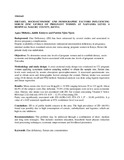Dietary, Socio-economic And Demographic Factors Influencing Serum Zinc Levels Of Pregnant Women At Naivasha Level 4 Hospital Nakuru County, Kenya

View/
Date
2013-06Author
Mitheko, Agnes
Kimiywe, Judith
Njeru, Patrisio N
Type
PresentationLanguage
enMetadata
Show full item recordAbstract
Background: Zinc Deficiency (ZD) has been witnessed by several studies and
associated to diverse pregnancy complications.
Despite availability of data to demonstrate widespread micronutrient deficiency in
pregnancy, minimal studies have examined serum zinc status among pregnant women
in Kenya. Hence the present study was undertaken.
Objectives: To determine serum zinc levels of pregnant women and to establish
dietary, socio-economic and demographic factors associated with serum zinc levels
of pregnant women in Naivasha.
Methodology and study design: A cross sectional study design was conducted on 172
pregnant women applying systematic random sampling method to obtain the sample
size. Serum zinc levels were analyzed by atomic absorption spectrophotometer. A
structured questionnaire was used to obtain socio and demographic factors amongst
the women. Dietary intake was assessed using 24-hr dietary recall and FFQ method.
Statistical analysis was done using logistic regression and linear regression.
Results: Mean serum zinc level was 66 μg/dl (+ 14 SD) ranging between 39 to 123
μg/dl. About 66.9% of the subjects were Zinc deficient. 75.0% of the participants
were in low socio-economic class. Dietary zinc intake was not associated with ZD,
but women consuming Vitamin C below RDA had 2.62-fold risk (95% CI: 0.55 –
12.37) of becoming ZD.
Parity was significantly associated with ZD (AOR=3.65; 95% CI: 1.27 – 10.49;
p=0.016). A p value of < 0.05 statistical significant at 95% confidence level was used.
Conclusions: ZD is of public health concern in the area. The high prevalence of ZD
(66.9%) found was possibly due to high consumption of cereals, carbohydrates and
legumes, which are high in zinc inhibitors.
Recommendations: The problem may be addressed through a combination of short,
medium and long term strategies. This includes nutrition education, household based
phytate reduction food processing techniques, economic empowerment and livelihood
promotion.
Citation
Agnes Mitheko, Judith Kimiywe and Patrisio Njiru N.;Dietary, Socio-economic And Demographic Factors Influencing Serum Zinc Levels Of Pregnant Women At Naivasha Level 4 Hospital Nakuru County, Kenya,presented at the 2nd International Scientific Conference, Chs And Knh, 19th - 21st June 2013.Publisher
University of Nairobi College of Health Sciences
Description
Dietary, Socio-economic And Demographic Factors Influencing Serum Zinc Levels Of Pregnant Women At Naivasha Level 4 Hospital Nakuru County, Kenya,presented at the 2nd International Scientific Conference, CHS And KNH, 19th - 21st June 2013.
